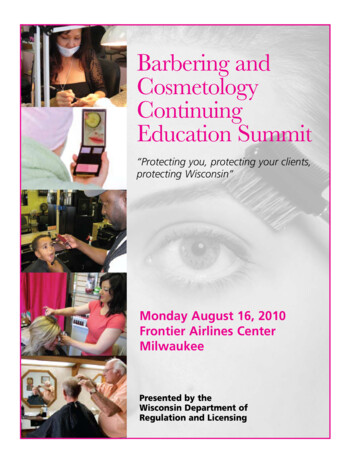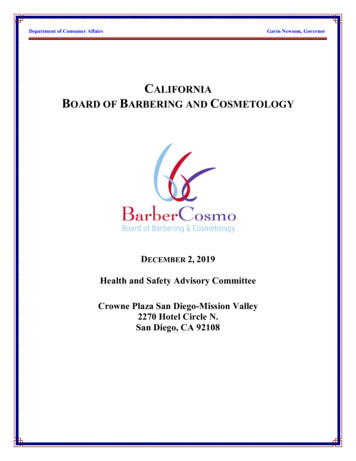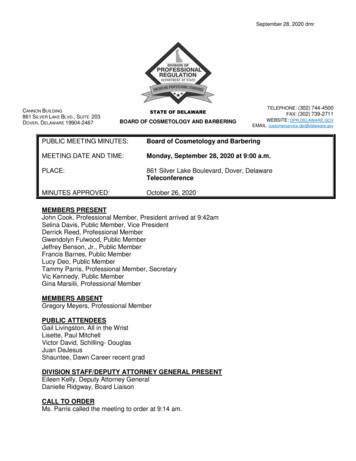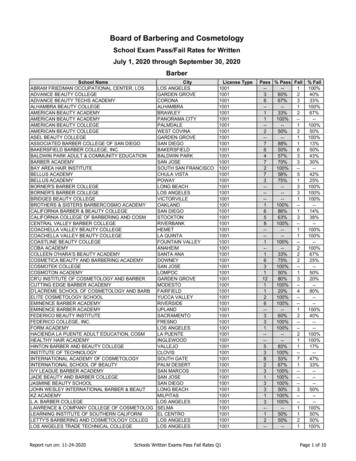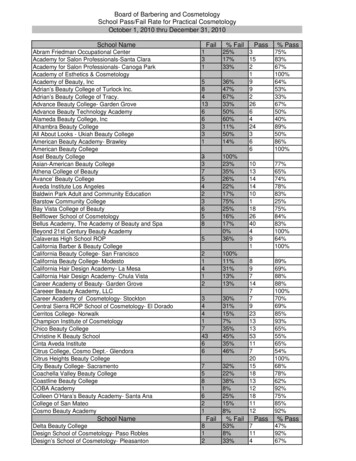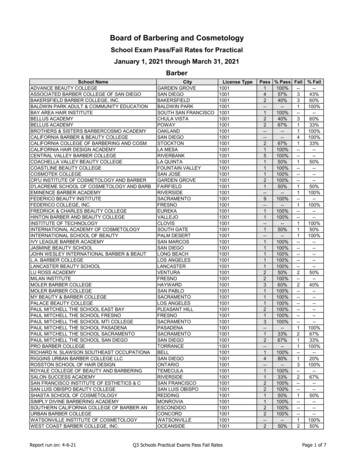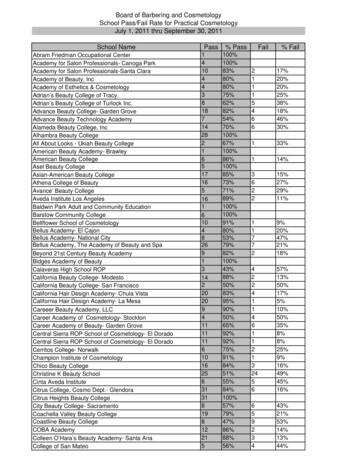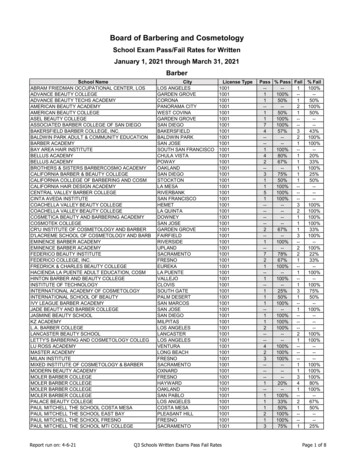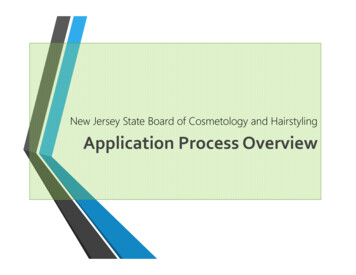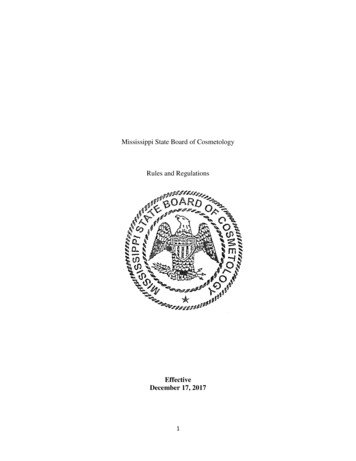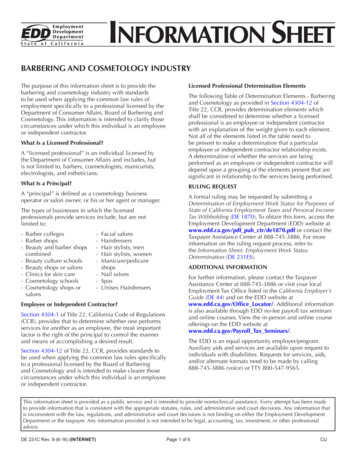
Transcription
BARBERING AND COSMETOLOGY INDUSTRYThe purpose of this information sheet is to provide thebarbering and cosmetology industry with standardsto be used when applying the common law rules ofemployment specifically to a professional licensed by theDepartment of Consumer Affairs, Board of Barbering andCosmetology. This information is intended to clarify thosecircumstances under which this individual is an employeeor independent contractor.What Is a Licensed Professional?A “licensed professional” is an individual licensed bythe Department of Consumer Affairs and includes, butis not limited to, barbers, cosmetologists, manicurists,electrologists, and estheticians.What Is a Principal?The following Table of Determination Elements - Barberingand Cosmetology as provided in Section 4304-12 ofTitle 22, CCR, provides determination elements whichshall be considered to determine whether a licensedprofessional is an employee or independent contractorwith an explanation of the weight given to each element.Not all of the elements listed in the table need tobe present to make a determination that a particularemployee or independent contractor relationship exists.A determination of whether the services are beingperformed as an employee or independent contractor willdepend upon a grouping of the elements present that aresignificant in relationship to the services being performed.RULING REQUESTA “principal” is defined as a cosmetology businessoperator or salon owner, or his or her agent or manager.The types of businesses in which the licensedprofessionals provide services include, but are notlimited to:- Barber colleges- Barber shops- Beauty and barber shopscombined- Beauty culture schools- Beauty shops or salons- Clinics for skin care- Cosmetology schools- Cosmetology shops orsalonsLicensed Professional Determination Elements-Facial salonsHairdressersHair stylists, menHair stylists, womenManicure/pedicureshops- Nail salons- Spas- Unisex HairdressersEmployee or Independent Contractor?Section 4304-1 of Title 22, California Code of Regulations(CCR), provides that to determine whether one performsservices for another as an employee, the most importantfactor is the right of the principal to control the mannerand means of accomplishing a desired result.Section 4304-12 of Title 22, CCR, provides standards tobe used when applying the common law rules specificallyto a professional licensed by the Board of Barberingand Cosmetology and is intended to make clearer thosecircumstances under which this individual is an employeeor independent contractor.A formal ruling may be requested by submitting aDetermination of Employment Work Status for Purposes ofState of California Employment Taxes and Personal IncomeTax Withholding (DE 1870). To obtain this form, access theEmployment Development Department (EDD) website atwww.edd.ca.gov/pdf pub ctr/de1870.pdf or contact theTaxpayer Assistance Center at 888-745-3886. For moreinformation on the ruling request process, refer tothe Information Sheet: Employment Work StatusDetermination (DE 231ES).ADDITIONAL INFORMATIONFor further information, please contact the TaxpayerAssistance Center at 888-745-3886 or visit your localEmployment Tax Office listed in the California Employer’sGuide (DE 44) and on the EDD website atwww.edd.ca.gov/Office Locator/. Additional informationis also available through EDD no-fee payroll tax seminarsand online courses. View the in-person and online courseofferings on the EDD website atwww.edd.ca.gov/Payroll Tax Seminars/.The EDD is an equal opportunity employer/program.Auxiliary aids and services are available upon request toindividuals with disabilities. Requests for services, aids,and/or alternate formats need to be made by calling888-745-3886 (voice) or TTY 800-547-9565.This information sheet is provided as a public service and is intended to provide nontechnical assistance. Every attempt has been madeto provide information that is consistent with the appropriate statutes, rules, and administrative and court decisions. Any information thatis inconsistent with the law, regulations, and administrative and court decisions is not binding on either the Employment DevelopmentDepartment or the taxpayer. Any information provided is not intended to be legal, accounting, tax, investment, or other professionaladvice.DE 231C Rev. 9 (6-16) (INTERNET)Page 1 of 6CU
TABLE OF DETERMINATION ELEMENTS – BARBERING AND COSMETOLOGYELEMENTSEVIDENCE OFEMPLOYEEWEIGHTINDEPENDENTCONTRACTOR(1)Policies or Rules,or Proceduresof ConductThe principal establishes thepolicies, rules, or procedures ofconduct that are followed by thelicensed professional such as,prices, business hours, refunds,operating the cash register, workschedules, lunch breaks,attendance, dress code, customercomplaint resolution, customerrelations, and maintaining aconcession of beauty products tothe general public.The licensed professional performs hisor her services independent of theprincipal’s policies, rules, orprocedures of conduct. The licensedprofessional establishes his or herown hours of work, sets his or her ownprices, directly collects payments fromhis or her customers, directlyschedules his or her clients’appointments, personally resolves anycustomer complaints related to his orher services, makes refunds tocustomers from his or her own funds,and determines his or her own mannerof dress. The licensed professional isnot required to sell the principal’s retailitems.This element carries great weight. When theprincipal sets policies, rules, or procedures ofconduct relating to the manner and means bywhich the licensed professional performs hisor her services, it strongly indicates a right ofdirection and control. The right of the principalto direct and control the manner and means bywhich the services are performed is theprimary test used to make an employmentrelationship determination. If that right exists,whether or not exercised, an employmentrelationship exists. Evidence that the principaldoes not have the ability to control the mannerand means by which the licensed professionalprovides services is equally indicative of anindependent contractor relationship.(2)Supervision onThe principal supervises the licensedprofessional. The principal givesinstructions that are followed by thelicensed professional. The principal orits representative is on the premises toobserve the licensed professional’sservices. The principal givesinstructions to the licensedprofessional regarding general clean up activities at the business facility.The principal assigns customers to thelicensed professional. The principalreviews or evaluates the performanceof the licensed professional bysoliciting comments from customers. Ifthe licensed professional is notperforming satisfactorily, the principalcan train, reassign, or terminate thelicensed professional.The licensed professional receives noinstructions or supervision from theprincipal. The licensed professionaldetermines whether or not a walk-incustomer will be served and can refuseto serve any customer. The licensedprofessional is fully responsible for his orher own work, and personally resolvesany customer complaints related to his orher services. The principal does notevaluate the licensed professional in anyway.This element carries great weight. The principal’ssupervision of the licensed professional isevidence that the principal has the right to controlthe services, and that this right of control iscomplete and authoritative. The right of control,whether or not exercised, carries the greatestweight in making an employment relationshipdetermination. Evidence that the principal doesnot have the ability to control the manner andmeans by which the licensed professionalprovides services is equally indicative of anindependent contractor relationship.the Job(3)TrainingThe principal provides training. Theprincipal requires the licensedprofessional to attend classes,seminars, or conferences. Theprincipal pays for the training.The principal does not provide training tothe licensed professional. If trainingclasses, seminars, or conferences aremade available, attendance is voluntary.Failure to attend carries no negativeconsequence. The licensed professionalpays for any training made available.This element carries medium weight. Trainingreceived from the principal covering policies,rules, and procedures, or instructions on how toperform the services, would indicate the principalhas the right to direct and control the services ofthe licensed professional.(4)MeetingsThe principal arranges meetings. Thelicensed professional is expected toattend. The licensed professional ispaid for time spent in meetings.The licensed professional is not expectedor required to attend staff meetings.Failure to attend carries no negativeconsequence. The principal does not paythe licensed professional for any timespent attending meetings.This element carries medium to high weight. Liketraining, if the purpose of a meeting is to conveypolicies, rules, procedures, or instructions onperforming services, it indicates that the licensedprofessional is not in control of his or her servicesand is an indication of employment.(5)Work SchedulesThe principal determines the hoursand days of the week the licensedprofessional will work. The principalrequires the licensed professional todevote full-time effort to production ofthe principal’s income. The principalmaintains a common appointmentbook. The principal sets the hours ofthe business, including opening andclosing times. The licensedprofessional has to perform his or herservices within the principal’s fixedbusiness hours. The licensedprofessional must adhere to the workschedule set by the principal. Theprincipal requires the licensedprofessional to be on the premisesduring certain hours for a minimumnumber of days per week.The licensed professional sets his or herown hours of work. The licensedprofessional sets his or her ownappointments. The licensed professionalhas the right to refuse any appointmentor refer a client to another professionallicensed by the Board of Barbering andCosmetology. The licensed professionalsets his or her own prices, directlycollects payments from his or hercustomers, personally resolves anycustomer complaints related to his or herservices, makes refunds to customersfrom his or her own funds, anddetermines his or her own manner ofdress. The licensed professional is notrequired to sell the principal’s retail items.This element carries medium to high weight.When the principal determines the hours anddates the licensed professional will work, it isstrong evidence of the right to control the servicesof the licensed professional, and carries greatweight in indicating an employment relationship.When the licensed professional has freedom todetermine when and how services are performed,and controls his or her schedule, medium to highweight is given toward independence.DE 231C Rev. 9 (6-16) (INTERNET)Page 2 of 6
TABLE OF DETERMINATION ELEMENTS – BARBERING AND COSMETOLOGYELEMENTSEVIDENCE OFEMPLOYEE(6)Location of Work(work station)(7)(8)Written Contractor AgreementTerminationWEIGHTINDEPENDENTCONTRACTORThe licensed professional cannotrender services for himself or herselfor other business establishmentswithout restriction. The principal is incontrol of the premises where theservices are provided since theprincipal holds the lease, owns theequipment, and holds theestablishment license. The licensedprofessional cannot sublet orrelinquish his or her chair(workspace). The licensedprofessional does not rent or lease aspecific booth (workspace).The licensed professional leases his orher workspace from the principal andpays a flat fee for rent, rather than apercentage of income. The licensedprofessional has keys to the premisesand is free to work any hours. Thelicensed professional is free to provideservices at other locations withoutinforming the principal.This element carries medium to high weight.When the principal controls the location whereservices are performed, it is strong evidence ofthe right to control the services of the licensedprofessional and would be an indication ofemployment.The written agreement between theprincipal and the licensed professionalgives the principal control over themanner and means by which thelicensed professional performsservices. The written agreementprovides that the licensed professionalhas to sell the principal’s retail beautyproducts to the general public. Theprincipal receives a percentage of feescollected and not a contracted flat ratefor booth (workspace) rental. Althoughthe written agreement states that thelicensed professional rents a particularchair, the principal assigns thelicensed professional to work atvarious chairs and controls his or herworking hours.The written agreement clearly explainsthe day-to-day working relationshipbetween and by each party to thecontract. The contract provides that thelicensed professional establishes his orher own hours of work, sets his or herown prices, directly collects paymentsfrom his or her customers, directlyschedules his or her clients’appointments, personally resolves anycustomer complaints related to his or herservices, determines his or her ownmanner of dress. The contract states thatthe licensed professional is not requiredto sell the principal’s retail products. Theagreement sets a flat rate of rent for theuse of the principal’s facilities by thelicensed professional.This element carries medium weight. Writtenagreements do not necessarily depict the actualrelationship. The actual practices of the parties ina relationship are more important than thewording of an agreement in making adetermination.Both the principal and the licensedprofessional have the right toterminate the relationship at will,without prior notice, and without anyfurther contractual liability (except forservices already performed). Theprincipal may terminate the contracton one day’s notice if there is aviolation of the written agreement, butthere is no such correspondingprovision for the licensed professional.The principal could immediatelyterminate the relationship fornoncompliance of the principal’spolicies. The licensed professionalcould be terminated for refusing toaccept an assignment. The principalcan reprimand and terminate alicensed professional for misconductor because of a customer complaint.The rental agreement may be terminatedby mutual agreement, or by either party’sviolation of the agreement’s terms (e.g.,failure to pay rent). The licensedprofessional would be liable to principalfor unpaid rent, and principal would owethe licensed professional for any prepaidrents.The question of the right to terminate therelationship carries great weight.DE 231C Rev. 9 (6-16) (INTERNET)Page 3 of 6This element would carry less weight if thelicensed professional is not allowed to possess akey to the premises because the property owner(third party) prohibits the distribution of keys toother workers or if the property owner dictates thehours of operation (shopping mall).A contract carries little weight if the contract leanstoward independence, but the actions of theparties point toward employment.The right to terminate the licensed professional atwill, without cause, is strong evidence ofemployment. The right to terminate conveys aninherent power of the principal over the licensedprofessional and shows the licensedprofessional’s likely submission to control by theprincipal.
TABLE OF DETERMINATION ELEMENTS – BARBERING AND COSMETOLOGYELEMENTSEVIDENCE OFEMPLOYEE(9)Engagement in aDistinct BusinessThe licensed professional does notoperate his or her own businessseparate from that of the principal.The services performed are anintegral part of the principal’sbusiness. The licensed professionalperforms all of his or her services atthe principal’s place of business andunder the principal’s name. Thelicensed professional does notadvertise his or her services. Theprincipal’s name is on the businesslicense. The business cards of thelicensed professional have theprincipal’s business identified on them.The principal sets the fees forservices, products, and merchandisepurchased by clients. The principalabsorbs the loss when the customerdoes not pay or issues a non negotiable check. The principal ineffect guarantees payment forservices rendered by the licensedprofessional and the licensedprofessional does not incur theentrepreneurial risk of loss. Theprincipal’s name is on the credit cardmachine. The principal providesliability insurance and worker’scompensation coverage. The principalassigns customers to the licensedprofessional. The principal maintainsan appointment book. If the licensedprofessional cannot perform orcomplete a job for a customer, he orshe is required to notify the principalwho arranges for a substitute. Thelicensed professional cannot work atanother location and take his or herown clients. The licensed professionaldoes not have clientele independent ofthe principal’s walk-in customers. Thelicensed professional is not engagedin an entrepreneurial venture or put ata financial risk. The professionallicensed by the Board of Barberingand Cosmetology collects thepayments from customers and placesall funds in a communal cash register.WEIGHTINDEPENDENTCONTRACTORThe licensed professional operates anindependent business separate from thatof the principal. The relationship betweenthe principal and the licensedprofessional is that of a landlord andtenant. The licensed professional has abusiness license where required, isproperly licensed by the Department ofConsumer Affairs for the type of servicesprovided, and advertises at his or herown expense, including the purchase ofhis or her own business cards. Thelicensed professional has his or herseparate clientele and the client lists arethe property of the licensed professionaland not the principal. The licensedprofessional is not required to participatein the principal’s advertised specials. Thelicensed professional pays for his or herown products and merchandise, andabsorbs losses from a client’s failure topay for services, or non-negotiablechecks. The licensed professional ispersonally responsible for his or her ownperformance and makes refunds tocustomers from his or her own funds.The licensed professional carries thenecessary liability insurance for theservices performed. Through this thelicensed professional bears theentrepreneurial risk of loss. The licensedprofessional sets his or her ownappointments. The licensed professionalsets his or her own hours of work. Thelicensed professional determineswhether or not a walk-in customer will beserved and can refuse to serve anycustomer, or refer a client to anotherlicensed professional. The licensedprofessional sets his or her own pricesand directly collects payments from his orher customers. The licensed professionalis free to provide services at otherlocations, without informing the principal.This element carries great weight. If the licensedprofessional does not have an establishedseparate business, distinct from that of theprincipal, and the services are performed in thefurtherance of the principal’s business, greatweight would be given towards employment. Ifthe licensed professional has a separatebusiness, distinct from that of the principal, wherehe or she can make business decisions, whichwould enable him or her to earn a profit or incur afinancial loss, great weight would be giventowards independence.I(10) Level of SkillIn this particular industry, both employees and independent contractors arerequired to have a license from the Department of Consumer Affairs to performcosmetology services.DE 231C Rev. 9 (6-16) (INTERNET)Page 4 of 6This element is neutral. The level of skill, by itself,is not controlling. However, a high level oftechnical skill will weigh towards independencewhen combined with other elements such asengagement in a distinct business, and lack ofsupervision. A low level of technical skill weighsin favor of employment, since
State of California Employment Taxes and Personal Income Tax Withholding (DE 1870). To obtain this form, access the . Written Contract The written agreement between the principal and the licensed professional gives the
